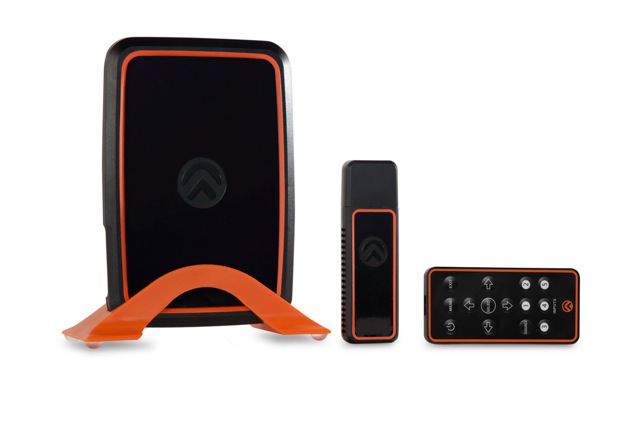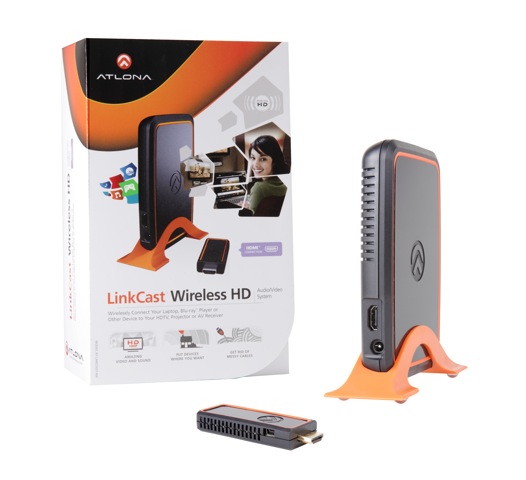The Atlona LinkCast is a genuinely plug-and-play solution; you can have this product up and running in — literally — one minute. It ships with the necessary cables that tech managers need (HDMI, USB, power), a sleek remote control, and an HDMI swivel adapter. The swivel adapter will prove useful if the transmitter/dongle needs more flexibility, e.g., if is going to hit the back of a cabinet, ceiling, or for some quirky console design.
I tested the LinkCast with a motley crew of laptops to put the device through its paces.
INSTANT ON
Here's how the system works: select your source device, plug in the LinkCast transmitter into its HDMI port along with the provided USB cable to power the transmitter. Then the connect the Receiver via HDMI cable to the projector and plug it into the power strip. It is ready for primetime instantly. No special drivers required. No extra set-up or keys required. The laptop with connected transmitter was on and as we fired up the projector we instantly saw the feed from Atlona that confirmed that everything was successfully connected. You can walk in between the devices, you can use other computer or mobile devices, and signal stays strong and uninterrupted. Not only is the projector 14 feet away from the laptop/transmitter, it's stored in a wood cabinet.
LOW-COST BYOD STRATEGY
This is a great solution for technology managers on a budget and facilities that need to support multiple users. You can buy up to four extra dongles to support multiple sources. This is a good option for technology managers tasked with conference room user support. If, for example, it's the day of a major corporate meeting, and you are about to welcome four different presenters to your conference room, you could hand each presenter a transmitter rather than trading cables back and forth. You can wirelessly transition between these four sources using the remote control.
Google Chromecast is the new $35 dongle for streaming Netflix and content from the Google Chrome browser. While Chromecast could work for a few aspects of home use, it is not device-agnostic and it doesn't check off the needs of educational or commercial applications. When I need to project in the classroom, show CAD renderings, or use wireless projection for training on a proprietary MOOC platform, the Chromecast might not work.
I asked Atlona’s media manager Raymond Moore to share his insight on this topic: “I think the LinkCast is different from the Chrome Cast as it serves a much wider range of applications and is compatible with more products. The LinkCast also does not require a Wi-Fi signal while the Chrome Cast will. I believe the LinkCast serves a wider market.”
IMAGE QUALITY
It displays 1080p which is ideal for projectors in the conference room, classroom, training room, or the home. We are testing the LinkCast with animations, 3D, HD video, and static imagery; it all looks excellent.
AUDIO QUALITY
My test laptop with the LinkCast hookup is connected via receiver to a 5.1 surround system. Wired sound and wireless video were flawless with zero latency or time lapse. This is a major pet peeve so I was really scrutinizing the sync. The video and audio tracks were perfect.
LINKCAST BENEFITS
• Easy to set up—one minute out of the box and you're good to go.
• Easy to use.
• Helps reduce unsightly wires from your install.
• You can place your source anywhere (even in a cabinet) or carry it anywhere and the signal stays strong.
• You can buy up to four extra transmitters/dongles and use multiple sources, e.g., you have a game console, laptop, and BluRay player—three sources you use regularly. You can buy additional transmitters and, from the remote control, select which source to display. It essentially can make all of your HDMI wireless.
• Wired sound and wireless video operated with no synch or latency problems.
• Remote control and batteries for the remote are included.
• Smart user manual with clear, precise instructions and great images.
LINKCAST CONS
• The LinkCast website says that it is not compatible with Apple products, but a few online forum users are connecting it to Macs with no problem. I also tested it with a MacBook Pro with no problems. But since the company states that they don’t support Macs, this could be tricky for universities, corporations, or organizations that are Apple-exclusive, or a BYOD environment.
• There is no way to change the source other than the remote; there are no buttons on the transmitter or receiver. So don't lose the remote.
• I am using this with a desk laptop and table-top projector, so install was easy. But it might take a little more time to insert the USB and dongle into a ceiling-mounted or retractable-projector.
• LinkCast requires a USB port for the dongle and an HDMI port. Most current devices come equipped with both, of course, but if you are working with a few hundred university professors on a campus, you never know what kind of legacy equipment they have.

SPECS
• Bandwidth:
Video - 3Gbps
Audio - 18Mbps
• Power Consumption: 7.5W
• Video:
Video: up to 1080p@60Hz
VESA: up to 1600x1200
• Dimensions
(H x W x D)
5.9 x 4.2 x 0.9 (inch)
152 x 104.7 x 23 (mm)
• Audio
up to Dolby Digital
or DTS 5.1
• Weight
0.29lbs
0.132kg
• Distance
40ft w/Laptops (1080p)
35ft w/1080p sources (24Hz)
25ft w/1080p sources (60Hz)
• Operating Temperature
50°F to 95°F
10°C to 35°C
Wall Mountable: Yes
• Storage Temperature
-4°F to 158°F
-20°C to 70°C
Package Includes
• 1 x AT-LinkCastAV
• 1 x AT-LinkCast-HTX
• 1 x 3' Mini USB to USB Cable
• 1 x 6' HDMI cable
• 1 x Remote
• 1 x Swivel Adapter
• 1 x AV Adapter
• 1 x User Manual
Margot Douaihy is a college instructor and editor of NewBay Media's AV Technology and EduWire.com.

